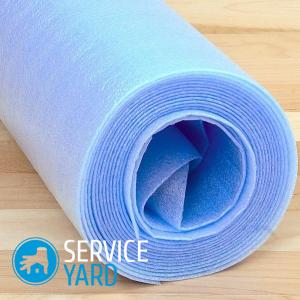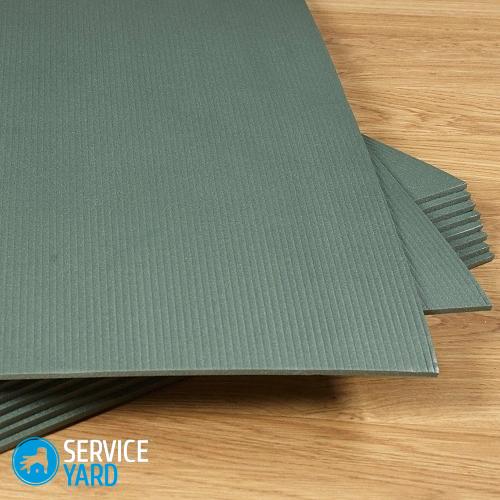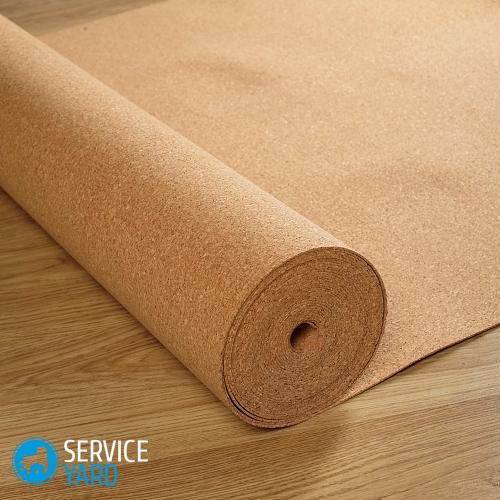Laminate flooring - an important point when laying the floor

Laminate is the most versatile option for decorative flooring today. It is much cheaper than parquet and wooden boards, although in appearance it can be made in a complete imitation of these materials, it is better in many properties and more presentable than linoleum and carpet, and its service life is quite attractive for those who do not want to repair often . But in order to get a really high-quality result upon completion of all finishing works, it is necessary to observe the rules of the technology for laying such a coating. To do this, you need to know which substrate under the laminate is better and how to choose it. This is what will be discussed in this article.
to contents ↑Why do I need a substrate?
The substrate for the laminate carries a certain functional load, therefore, it is unacceptable to ignore the stage of its selection and laying. To understand how important this is, it’s enough to know that the substrate under the laminate provides:
- additional sound insulation, which is very important in cases of a large number of household appliances in the house or when living in an apartment of a multi-storey building with “very thin walls”;
- improved thermal insulation, which will improve the heat-saving properties of the room and save on its heating;
- saving money on rough work, since preliminary careful leveling of the floor is not required, because the substrate will level minor surface defects and height differences;
- protection against moisture, temperature fluctuations, which is very important for observing the correct operating conditions of the laminate;
- the correct distribution of the load on the surface of the floor covering, which entails a longer period of operation of the material as a whole.
to contents ↑Important! A correctly selected substrate for the laminate will prevent the deformation of the planks, their creaking, will create the effect of optimal cushioning when walking, which will significantly increase the comfort of residents when moving around the room.
Requirements for choosing the right substrate
Before deciding which substrate to choose for the laminate, you need to understand what properties it should have.
Important! Be sure to consider the price factor, since it is impractical to purchase a very expensive substrate for economy-class material and vice versa.
The main selection criteria for such a material are:
- the operating conditions of a particular room, that is, the assumed stable values of temperature and humidity;
- thickness;
- hygienic cleanliness;
- simplicity of laying;
- properties for such important parameters as sound insulation, durability, moisture resistance, fire resistance.
Types of Substrate
The widest assortment of substrates of a different production method, price, characteristics, and purpose is presented on the building materials market today. The following materials are considered the most suitable in order to make a competent laying of the laminate:
- bung;
- coniferous substrate;
- polyethylene foam;
- polypropylene;
- composite materials.
to contents ↑Important! Depending on the raw materials in the basis and form of release, the thickness of the substrate under the laminate will change. And this criterion is also significant.Here the selection principle is this: the worse the quality of the base, the more defects and irregularities on it, the worse the insulation of the room, the thicker the material should be.
Bung
A cork laminate substrate is an excellent solution when choosing a material of any class. Excellent performance, favorable price, a variety of forms of release allow you to choose exactly the material that best suits exactly the conditions of your room.
Release Forms
Such a laminate substrate is commercially available in the following variations:
- rolled web - thickness is 2-8 mm, length - 8-10 m;
- plates with a thickness of 1 to 5 mm, sizes 60 * 30 and 60 * 60 mm.
Structure
The base of the cork backing is compressed cork chips. But manufacturers of such building and finishing materials, striving to still improve the already good coating properties, are expanding their model lines with such modifications:
- cork-bitumen substrate for a laminate;
- cork rubber.
Benefits:
- High strength.
- Durability.
- Perfect hygienic cleanliness.
- Resistance to decay.
- Resistance to mechanical damage.
- Flexibility and high shock absorbing performance.
- The ability to level even large differences in the height of the base of the floor without additional expenses.
to contents ↑Important! The disadvantage of such a substrate for a laminate can be called only a lower threshold of moisture resistance compared to alternative materials for this purpose. Therefore, this type of web is usually used in combination with waterproofing with a thickness of 1.5 mm or more. But if you use not a simple cork, but with the inclusion of bitumen or rubber, then it is suitable without auxiliary waterproofing materials even for rooms with unstable or high humidity levels.
Coniferous
Coniferous substrate is another type of natural, environmentally friendly material, all of the properties and characteristics of which are determined by the initial qualities of valuable wood species. That is why such a substrate for a laminate is the best, but accordingly - and the most expensive.
Important! Due to the high cost of the material, it is advisable to use it in combination with a laminate of the corresponding quality class.
Release form
Coniferous substrates are boards of various sizes, which makes the entire installation process very convenient, easy and fast. It is very simple to select the required parameters of the modules and thickness in order to perform laying without residues and additional trimming.
Benefits:
- High strength and wear resistance.
- Excellent performance characteristics such as noise and heat insulation.
- Good density, which eliminates deformation, sagging flooring, the appearance of an unpleasant creak after a long operation of the laminate.
- An opportunity to reduce all preparatory work to a minimum and thoroughly save on floor leveling.
- Resistance to moisture.
- Vibration damping.
to contents ↑Important! Disadvantages of such material, in addition to its high cost, no.
Polyethylene Foam - Pros and Cons
Polyethylene foam is one of the most popular synthetic materials, which is used to solve various technical problems in construction and finishing works. It is also suitable as a substrate for a laminate.
Advantages:
- Biostability - the material is not susceptible to mold fungi, is not interesting to rodents, insects.
- Mechanical resistance.
- Inertness to moisture.
- Optimum thermal insulation properties.
- Chemical resistance, due to which it is ideal if you need to choose a substrate for a laminate on a concrete floor.
- Low cost.
to contents ↑Important! Such material also has drawbacks and they are as follows:
- fully synthetic chemical composition, although harmless to humans;
- the possibility of loss of elasticity during operation, as a result - the laminate can sag and deform;
- with constant exposure to ultraviolet radiation in sunny rooms, the structure of polyethylene foam is destroyed.
Foamed Propylene
If the main goal when laying the flooring is the maximum possible savings, foamed propylene is the best substrate for the laminate.
Advantages:
- Good noise and heat insulation due to the porous structure.
- Breathability.
- Moisture resistance and good protection against condensate.
- Optimum durability.
to contents ↑Important! Before choosing such a substrate for the laminate, consider its shortcomings - they are also significant:
- exposure to fire;
- relative toxicity;
- maximum service life - 7 years with high quality material.
Composite
A composite substrate for a laminate is a multilayer roll coating that incorporates a protective polymer film from 2 sides and a polystyrene foam filler.
Advantages:
- Moisture resistance.
- Inconsistency with condensation.
- Optimum durability.
- Minimum thickness with good cushioning.
- Durability.
to contents ↑Important! The disadvantages include the completely artificial composition of the components.
Top backing manufacturers
To finally decide which substrate to choose for a laminate for an apartment, pay attention to the products of manufacturers that have won the trust of consumers. These are materials from brands:
- Isoplat;
- Silent Move;
- Teplon;
- Arbiton;
- Isolon;
- Tuplex
- Parklog;
- Isoshum.
Stock footage
We hope that after reading the information from this review, you have no doubts as to which substrate under the laminate is better for you. Choose decoration materials wisely and then the beautiful interior created will retain its original appearance for a long time, and you will feel comfortable in your reliable and durable home.
- How to choose a vacuum cleaner taking into account the characteristics of the house and coatings?
- What to look for when choosing a water delivery
- How to quickly create comfort at home - tips for housewives
- How to choose the perfect TV - useful tips
- What to look for when choosing blinds
- What should be running shoes?
- What useful things can you buy in a hardware store
- Iphone 11 pro max review
- Than iPhone is better than Android smartphones





